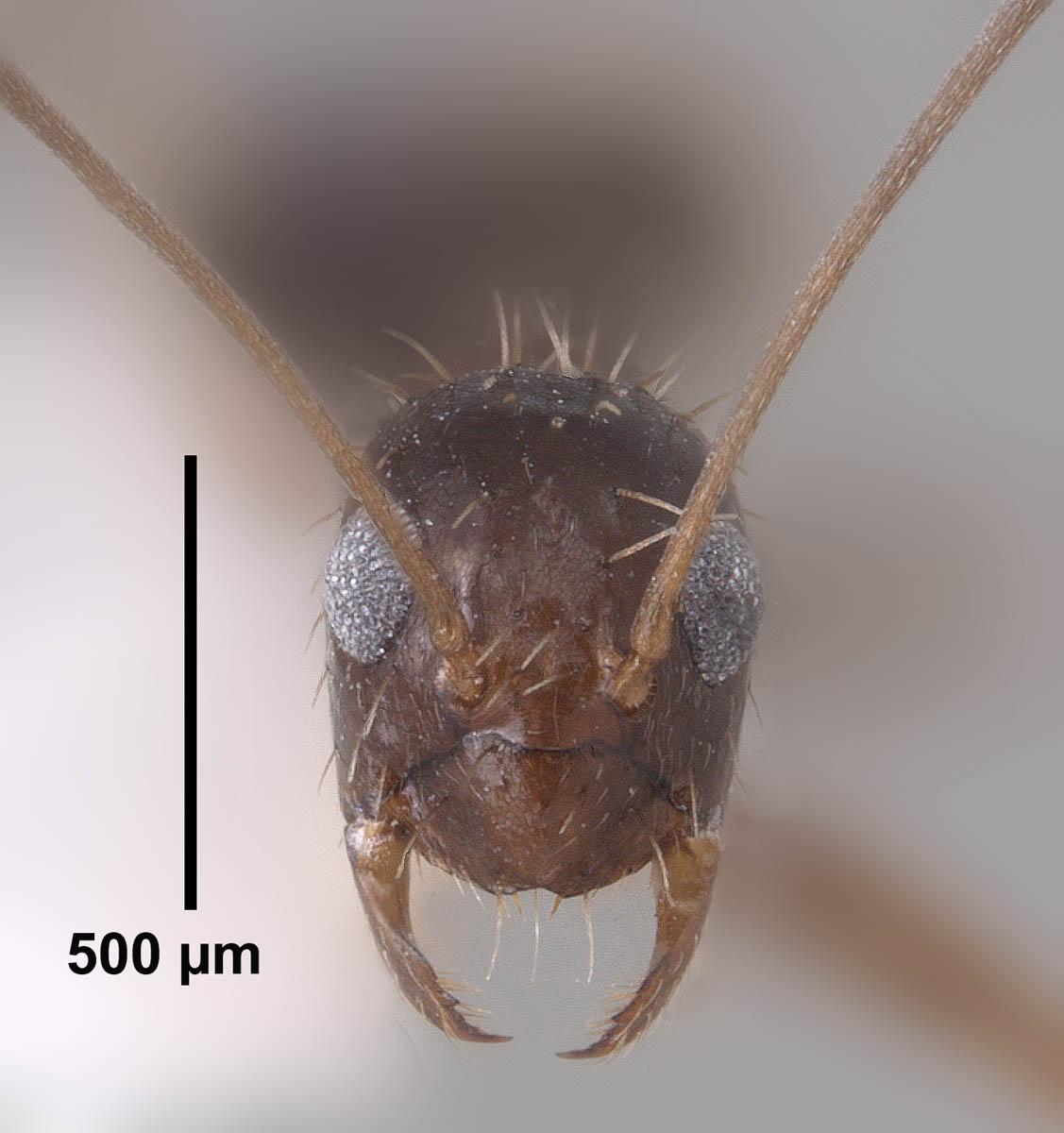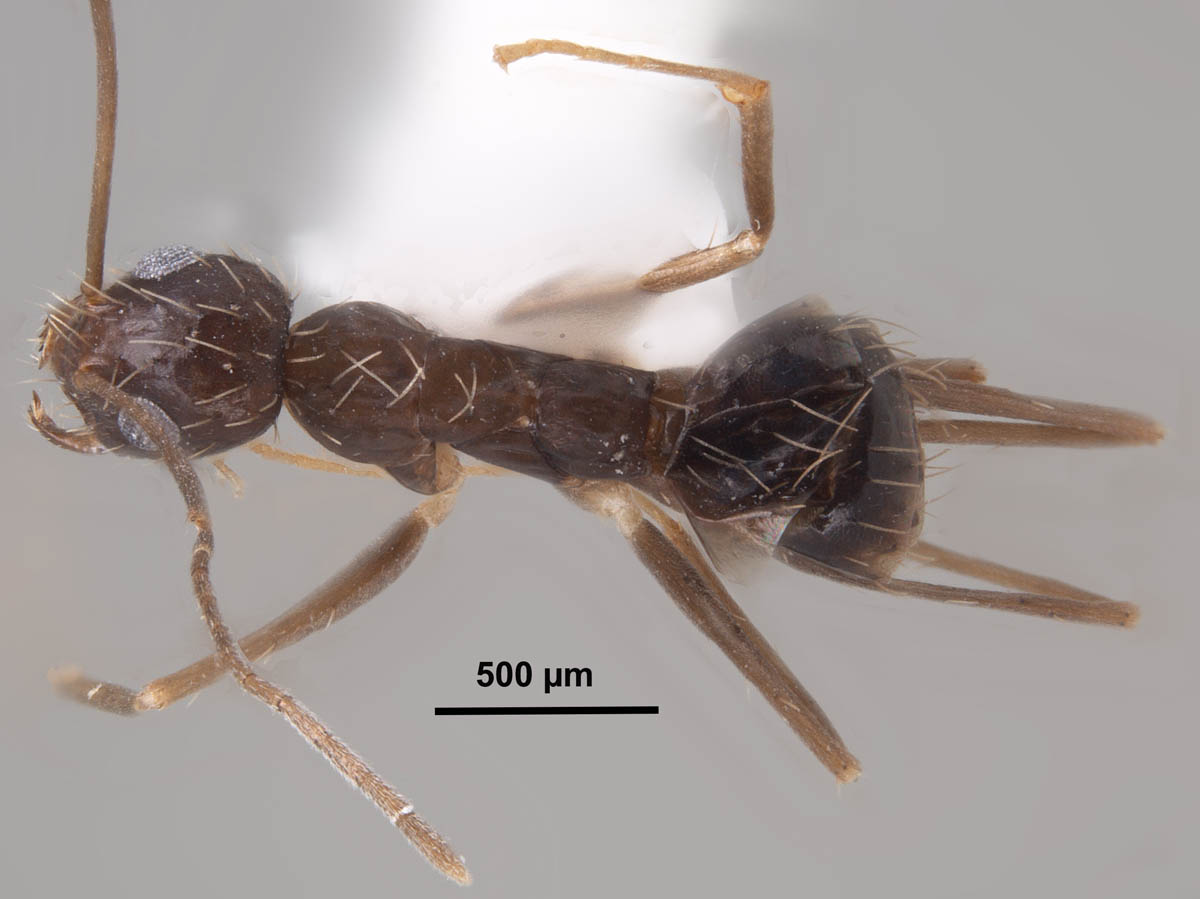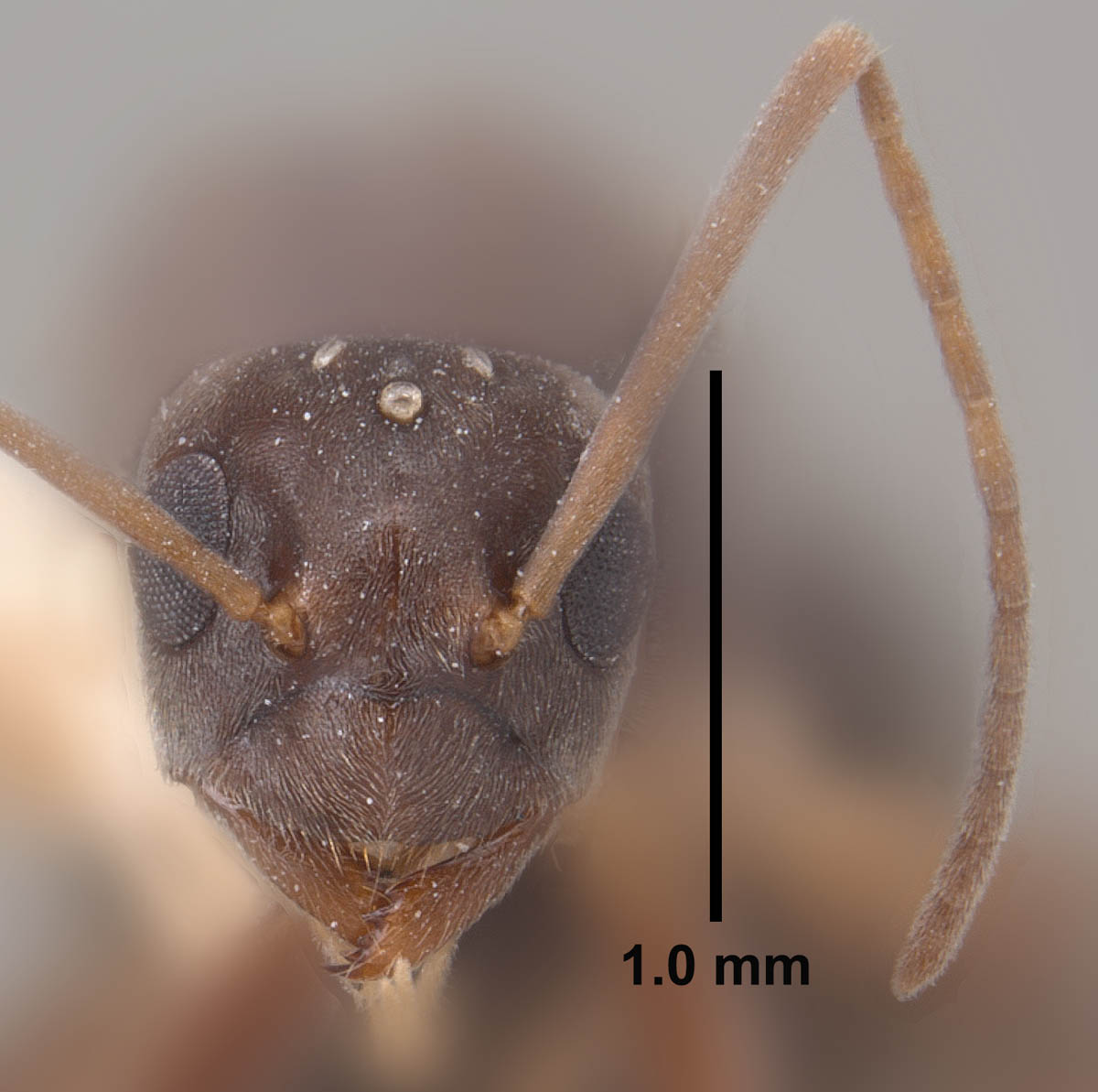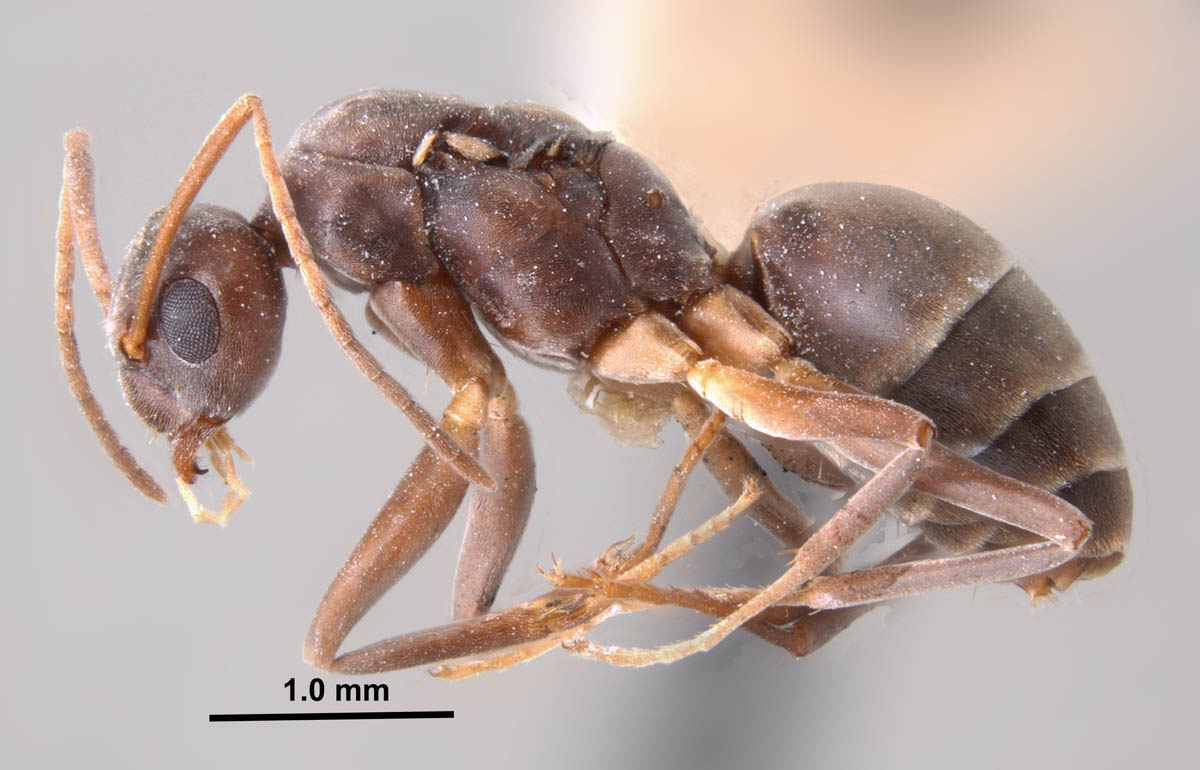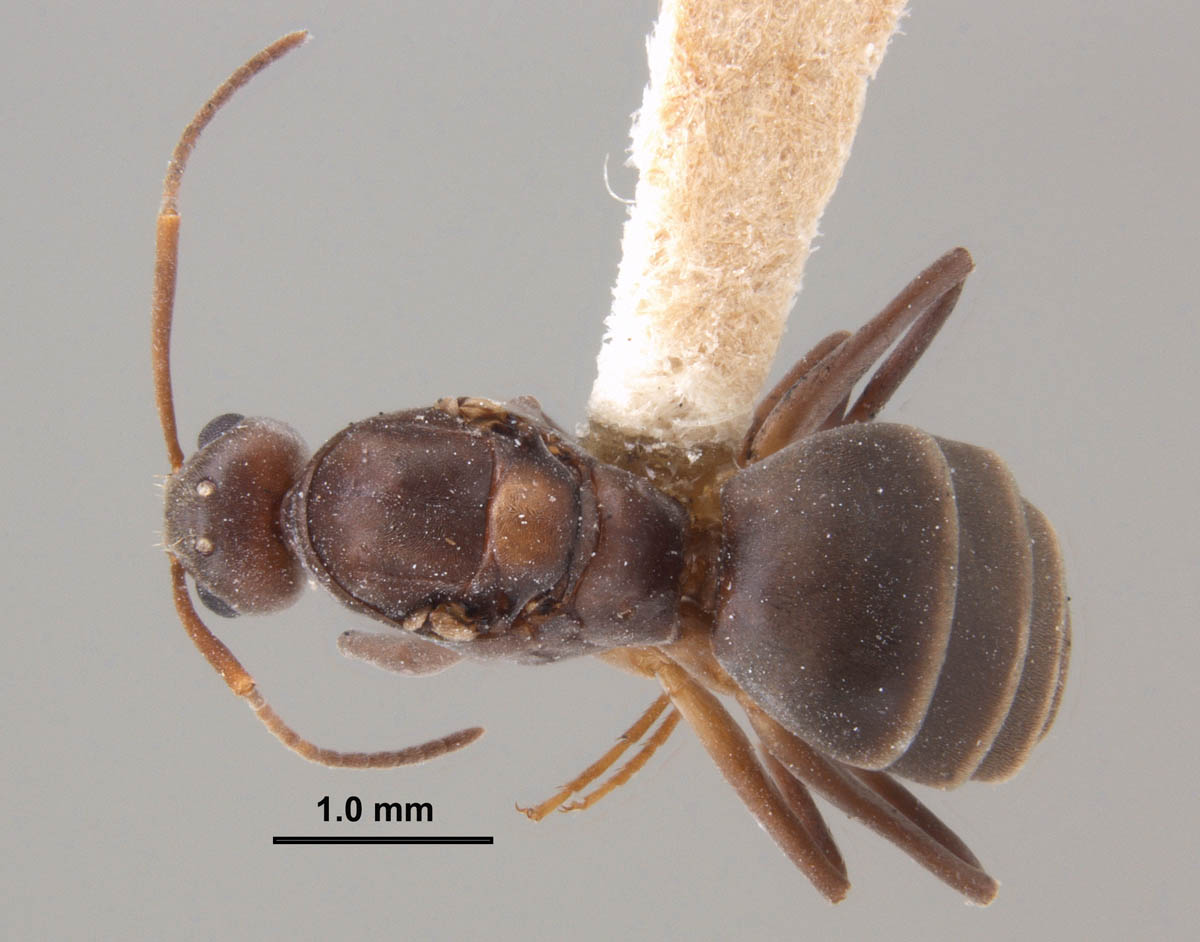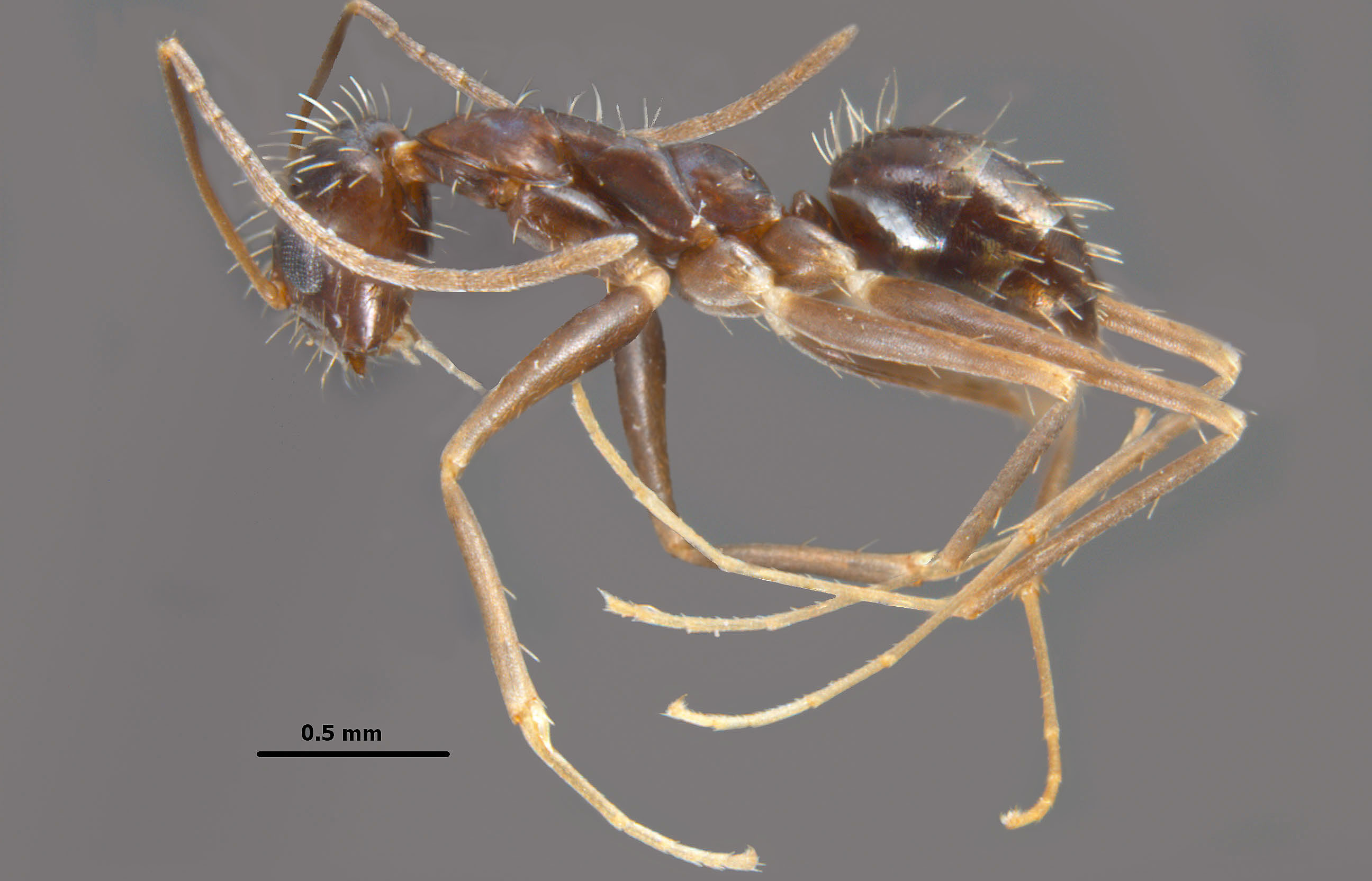Subfamily FORMICINAE
|
||
Paratrechina longicornis, full face view of a worker(MS, Hancock Co.) (photo by Joe A. MacGown) |
Paratrechina longicornis, lateral view of a worker(MS, Hancock Co.) (photo by Joe A. MacGown) |
Paratrechina longicornis, dorsal view of a worker(MS, Hancock Co.) (photo by Joe A. MacGown) |
Paratrechina longicornis, full face view of a queen (FL, Seminole Co.) (photo by Joe A. MacGown) |
Paratrechina longicornis, lateral view of a queen (FL, Seminole Co.) (photo by Joe A. MacGown) |
Paratrechina longicornis, dorsal view of a queen (FL, Seminole Co.) (photo by Joe A. MacGown) |
Paratrechina longicornis, lateral view of a worker(MS, Jackson Co.) (photo by Joe A. MacGown) |
||
Introduction Paratrechina species can be identified by having a waist with one distinct segment; acidopore at the apex of the gaster with a circular fringe of setae; 12-segmented antennae; triangular mandibles with five teeth; six-segmented maxillary palps; head and body with dorsally erect, coarse setae; very long antennal scapes and legs; and weakly shining integument with sparse pubescence. Paratrechina longicornis (Latreille), (Formicinae) the long legged crazy ant, is a small, elongate, long-legged, dark brown ant thought to be native to either Africa or Asia. This pantropical species is the only member of the genus found in North American where it is an ocassional nuisance pest. It is believed to have first entered the United States through Florida and has now spread across the Gulf Coast and southeastern coastal states. Taxonomic History (Bolton 2016) Diagnosis Identification Queen: Average sized, about twice the size of workers (HL 1.06 mm, HW 1.03 mm, SL 1.40 mm, EL 0.39 mm, MeSL 1.92 mm) (n=1) (MEM specimen). Head and body dark brown; fore coxae, femora, and tibia brown; antennae, mid and hind coxae, trochanters, and tarsi yellowish brown. Head about as long as wide, squarish; finely shagreened beneath dense, short, appressed, fine, pubescence; longer, erect setae absent; eyes large, about 1/3 the length of the head, located near midline of the head; three ocelli present; antennae 12-segmented, elongate, lacking club, lacking erect macrochaetae; scape elongate, about 1.5 times head length; clypeus convex, anterior border broadly rounded, shallowly notched medially; mandibles triangular, with five distinct teeth; maxillary palps long. six-segmented. Mesosoma robust, lightly shagreened beneath dense, short, appressed, fine, pubescence; longer erect setae absent; pronotum rectangular in lateral view; propodeum lacking spines, declivity gently sloped. Wings with dusky yellow brown tint; forewing with closed costal, basal, and marginal cells. Waist single segmented; petiolar node short in comparison to the gaster and often obscured by the anterior edge of the gaster in the dorsal view. Gaster covered in dense pubescence; lacking sting; acidopore present at apex. Male: (No specimens in MEM; description based on antwiki.org pictures). Head, antennal scapes, femora, and tibia brown; mesosoma, waist, petiole, funiculi, coxae, and tarsi yellowish brown; gaster dark brown; legs, especially joints, lighter colored than the body. Head about as long as wide, spherical; weakly shining with very feint reticulation; sparse, short, hair-like setae present, especially anterior to eyes; a few coarse, long, erect macrochaetae present; eyes distinctly convex, large, about 1/3 the length of the head, located at the midpoint of the head; three ocelli present; antennae 13-segmented, elongate, lacking club, scape elongate; clypeus broadly rounded, anterior border straight to very slightly concave; mandibles reduced; maxillary palps long and six-segmented. Mesosoma mostly glabrous and shining with some coarse, erect setae; dorsum smoothly curved from mesoscutum to base of propodeum. Wings with light grayish brown tint; forewing forewing with closed costal, basal, and marginal cells. Waist single segmented; petiolar node triangular from lateral view. Gaster shining, mostly glabrous except for a few scattered, appressed fine setae; numerous long, erect setae present, especially at sclerite margins and apically; genitalia present at apex, parameres somewhat squared in ventral view, penivalva extend beyond volsella. Biology Pest Status Distribution Australian: Australia, Barrow Island, Cook Islands, Fiji, French Polynesia, Guam, Hawaii, Indonesia, Kiribati, Marshall Islands, Micronesia, New Caledonia, New Guinea, New Zealand, Niue, Norfolk Island, Northern Mariana Islands, Palau, Samoa, Solomon Islands, Timor-Leste, Tokelau, Tonga, Tuvalu, Vanuatu (AntWeb.org). U.S. Distribution: AL, AZ, CA, FL, GA, HI, LA, MS, NC, SC, TX (AntWeb.org and MEM). Acknowledgments Literature Cited Bolton, B. 2016. Bolton World Catalog Ants. Available online: http://www.antweb.org/world.jsp. Accessed 9 March 2016. Dalla Torre, K. W. 1893. Catalogus Hymenopterorum hucusque descriptorum systematicus et synonymicus. Vol. 7. Formicidae (Heterogyna). Emery, C. 1892 ("1891"). Note sinonimiche sulle formiche. Bullettino della Società Entomologica Italiana 23:159-167. Emery, C. 1910. Beiträge zur Monographie der Formiciden des paläarktischen Faunengebietes. (Hym.) Teil X. Deutsche Entomologische Zeitschrift 1910:127-132. Forel, A. 1891. Les Formicides. [part]. In: Grandidier, A. 1891. Histoire physique, naturelle, et politique de Madagascar. Volume XX. Histoire naturelle des Hyménoptères. Deuxième partie (28e fascicule). Paris: Hachette et Cie, v + 237 pp. Forel, A. 1894. Les Formicides de l'Empire des Indes et de Ceylan. Part IV. Journal of the Bombay Natural History Society 8:396-420. Fox, E.G.P.; Solis, D.R.; Jesus, C.M.; Bueno, O.C.; Yabuki, A.T.; Rossi, M.L. 2007. On the immature stages of the crazy ant Paratrechina longicornis (Latreille 1802) (Hymenoptera: Formicidae). Zootaxa 1503: 1-11. Hung, A. C. F.; Imai, H. T.; Kubota, M. 1972. The chromosomes of nine ant species (Hymenoptera: Formicidae) from Taiwan, Republic of China. Annals of the Entomological Society of America 65:1023-1025. Jerdon, T. C. 1851. A catalogue of the species of ants found in Southern India. Madras Journal of Literature and Science 17:103-127. LaPolla, J. S.; Brady, S. G.; Shattuck, S. O. 2010. Phylogeny and taxonomy of the Prenolepis genus-group of ants (Hymenoptera: Formicidae). Systematic Entomology 35:118-131. LaPolla, J. S.; Hawkes, P. G.; Fisher, J. N. 2013. Taxonomic review of the ant genus Paratrechina, with a description of a new species from Africa. Journal of Hymenoptera Research 35:71-82. Latreille, P. A. 1802. Histoire naturelle des fourmis, et recueil de mémoires et d'observations sur les abeilles, les araignées, les faucheurs, et autres insectes. Paris: Impr. Crapelet (chez T. Barrois), xvi + 445 pp. Mayr, G. 1865. Formicidae. In: Novara Expedition 1865. Reise der Österreichischen Fregatte "Novara" um die Erde in den Jahren 1857, 1858, 1859. Zoologischer Theil. Bd. II. Abt. 1. Wien: K. Gerold's Sohn, 119 pp. Roger, J. 1863. Verzeichniss der Formiciden-Gattungen und Arten. Berliner Entomologische Zeitschrift 7(Beilage):1-65. Smith, M. R. 1965. House-infesting ants of the Eastern United States, their recognition, biology, and economic importance. United States Department of Agriculture, Technical Bulletin No. 1326: i-105. Trager, J. C. 1984. A revision of the genus Paratrechina (Hymenoptera: Formicidae) of the continental United States. Sociobiology 9:49-162. Wheeler, W. M. 1921. Chinese ants collected by Prof. C. W. Howard. Psyche (Cambridge) 28:110-115. Wheeler, G. C.; Wheeler, J. 1986. Supplementary studies on ant larvae: Formicinae (Hymenoptera: Formicidae). Journal of the New York Entomological Society 94:331-341. Links |
||


